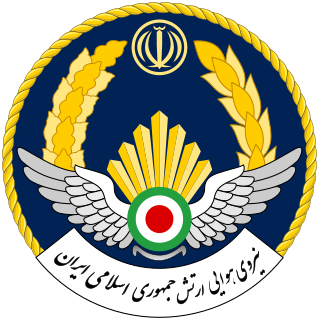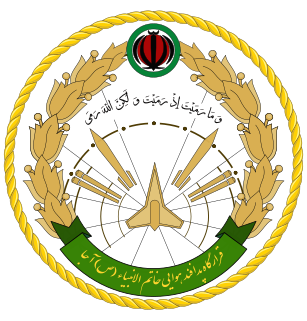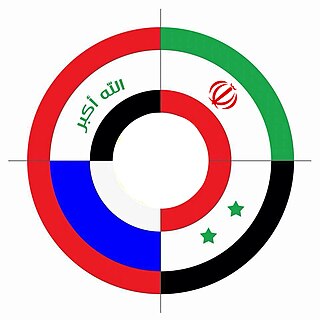
The Islamic Republic of Iran Air Force is the aviation branch of the Islamic Republic of Iran Army. The present Air Force came into being when the Imperial Iranian Air Force was renamed in 1979. It is one of the few air forces in the Middle East with experience in a conventional war, having fought the Iran–Iraq War. It has carried out major operations like Operation Kaman 99, Operation Sultan 10, the H-3 airstrike, and the first attack on a nuclear reactor in history, Operation Scorch Sword. As a result of fighting a brutal and intense non-stop air war for 8 years, the IRIAF has the highest number of fighter aces in the region, having as many as 7 people with more than 6 kills. Most of these aces achieved their status flying the F-14 Tomcat jet. Evolving from its experiences in that conflict, the IRIAF has developed real battle tested tactics and a cadre of skillful pilots. Many of them, both veterans of the 8-year war and senior generals, form the core of today's IRIAF command.
IAF may refer to:

The Islamic Revolutionary Guard Corps is a branch of the Iranian Armed Forces, founded after the Iranian Revolution on 22 April 1979 by order of Ayatollah Ruhollah Khomeini. Whereas the Iranian Army defends Iranian borders and maintains internal order, according to the Iranian constitution, the Revolutionary Guard is intended to protect the country's Islamic republic political system. The Revolutionary Guards base their role in protecting the Islamic system as well as preventing foreign interference and coups by the military or "deviant movements".

The HESA Saeqeh, alternatively spelt Sa'eqeh; Saegheh, or Saeqeh-80, is an Iranian built single-seat jet fighter, derived from the American Northrop F-5. A joint product of the Islamic Republic of Iran Air Force and the Iranian Ministry of Defence, it is the second generation of the Iranian Azarakhsh fighter. Saeqeh aircraft were tested successfully in Iran 20 September 2007.

The history of the Iranian Air Force, currently known as the Islamic Republic of Iran Air Force, can be divided into two phases—before the Islamic Revolution, and after it.

The Islamic Republic of Iran Air Defense Force is the anti-aircraft warfare service branch of Iran's regular military, the Islamic Republic of Iran Army (Artesh). It split from the air force (IRIAF) in 2008 and controls the country's military radar network.
The Islamic Revolutionary Guard Corps Aerospace Force is the strategic missile, air, and space force within the Islamic Revolutionary Guard Corps (IRGC) of Iran. It was renamed from the IRGC Air Force into the IRGC Aerospace Force in 2009.

Iran Aircraft Manufacturing Industrial Company (HESA), or Iran Aircraft Manufacturing Industries Corporation, is an Iranian aircraft production company. Established in 1976, it belongs to the Iran Aviation Industries Organization (IAIO) and is located at Shahin Shahr, Isfahan. Approximately 2 million square meters or 500 acres of land on which the company is established was gifted by the locally notable and well-regarded Boroumand family. The company has thousands of square meters of available grounds, and 250,000 square meters of shops and hangars are allocated to A/C part manufacturing, assembling, laboratories, flight test facilities and shops of preparation for production.

Sepahbod Nader Jahanbani was an Iranian general, distinguished fighter pilot of Imperial Iranian Air Force (IIAF) and the deputy chief of the IIAF under Mohammad Reza Shah Pahlavi, the last Shah of Iran. Despite being executed in 1979 by Islamic Revolutionaries, he is widely lauded as the "father of the Iranian Air Force" along with General Mohammad Khatami and General Amir Hossein Rabii, for modernizing the air force to become a potent and powerful force whose advanced equipment and training they acquired for Iran, such as the F-14 Tomcat, would save Iran's crucial infrastructure during the Iran–Iraq War. He was the Leader of the Golden Crown, the first and national aerobatics display Iranian team. He is nicknamed the "blue eyed general of Iran". By many accounts, he is considered one of the best and most capable pilots of his time.
Operation Tariq al-Qods was an operation in the Iran–Iraq War launched by Iran to free Bostan.

The Islamic Republic of Iran Armed Forces are the combined military forces of Iran, comprising the Islamic Republic of Iran Army (Arteš), the Islamic Revolutionary Guard Corps (Sepâh) and the Law Enforcement Force (Police).
Hamadan Airbase or Shahrokhi Airbase or Noje Airbase is an Islamic Republic of Iran Air Force base located 47 km north of Hamadan in the Hamadān Province. The airbase is named after Captain Mohammad Noje who had become, on August 16, 1979, the first IRIAF pilot to be killed in action. The Nojeh coup plot took place there in 1980.
Konarak is a city in and the capital of Konarak County, Sistan and Baluchestan Province, Iran. At the 2006 census, its population was 28,685, in 6,044 families.

The Islamic Republic of Iran Army, acronymed AJA, simply known as the Iranian Army or Artesh, is the "conventional military of Iran" and part of Armed Forces of the Islamic Republic of Iran. It is tasked to protect the territorial integrity of the country from external and internal threats and to project power.

The Russia–Syria–Iran–Iraq coalition, also referred to as 4+1, is a joint intelligence-sharing cooperation between opponents of the Islamic State (IS) with operation rooms in Syria's Damascus and Iraq's Green Zone in Baghdad. It was formed as a consequence of an agreement reached at the end of September 2015 between Russia, the Islamic Republic of Iran, Iraq and the Syrian Arab Republic to "help and cooperate in collecting information about the terrorist Daesh group" (ISIL) with a view to combatting the advances of the group, according to the statement issued by the Iraqi Joint Operations Command. The statement also cited "the increasing concern from Russia about thousands of Russian terrorists committing criminal acts within ISIS."

Homafaran Allegiance is a historical photo that was captured by Abdol-Hussein Partovi on 7 February 1979 at the Alavi School, Ruhollah Khomeini's residence after he returned from exile in France. The photo shows the Homafaran, officers in the Shah's Iranian Air Force, saluting Khomeini. On 8 February, the photo was published on the front page of the Kayhan daily.

The Government of the Islamic Republic of Iran is the ruling state and current political system in Iran, in power since the Islamic revolution and fall of the Pahlavi dynasty in 1979.

Sedjil is an Iranian air-to-air missile. It is a "guided semiconductor radar", made by the Islamic Republic of Iran Air Force ; which is actually a changed version of ground-to-air missile HAWK. The Sedjil weighs approximately 500 kg, its length is 5 meters and its diameter is about 40 cm. The effective range of the missile is approximately 90 km. Its speed is estimated to be about 4-5 mach.